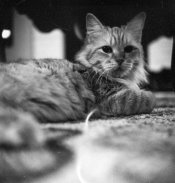Nice cat. Good suggestions to fix your issues, which thankfully are pretty minor. Easy to re shoot the shot too. This is the reason why I normally shoot many versions of the same shot when photographing something like this (our cat is a favorite subject too, and a patient poser). Is that Tri-X? I like the tones. The composition worked out. My eye goes to the lower right, over to the tail area on the left, and is directed right to the face, where the black background keeps it there. The light areas that frame the face on either side are perfect for keeping the attention on the eyes, and add balance (two light areas, two dark areas). One of the best ways to make a composition work is to have a repeating pattern and/or tonal value. Not a lot, and not contrived, but it will really nail the thing.
I wouldn't crop it. While as Thomas said, there may not be anything meaningful in the lower half, it's absolutely necessary for compositional balance. I see so many good shots ruined by lousy compositions. The libraries have books on basic compositional techniques in paintings. Avoid the photography books on the subject, as they usually have not a clue on this. Some people have composition hard wired and don't need the help, but it's good to know how to fix things when they need fixing. There's not a lot going on in traditional Asian art either in many areas of the image, but negative space is just as important as positive. The main thing you have going for you is that the four corners are darkened. Again, this gives a peaceful balance, and keeps the eye in the print, w/o wandering outside of it. Our attention will always go to the eyes in a portrait, which is fine, usually, if it's in the center, but on yours, my eye goes from the face, then sloooowly to the approximate center of the image where it rests, and there is a gentle tension between the eyes and that center resting area, which is perfect. Even though my mind wants my eye to go back to the face a little, it rests gently in that center darkish area area just before the lighter face, and from there, w/o focusing on any one area, I can see the whole image as an abstract of shape and tone. Good square, compositional portraits, cat or otherwise, are hard to do. Don't screw it up.
Photographs are nearly always seen as 2 dimensional, w/o depth like a painting, but you have a definable foreground, middle ground, and background. That is not that easy to get, especially in such a "simple", one subject image, as you have there.













